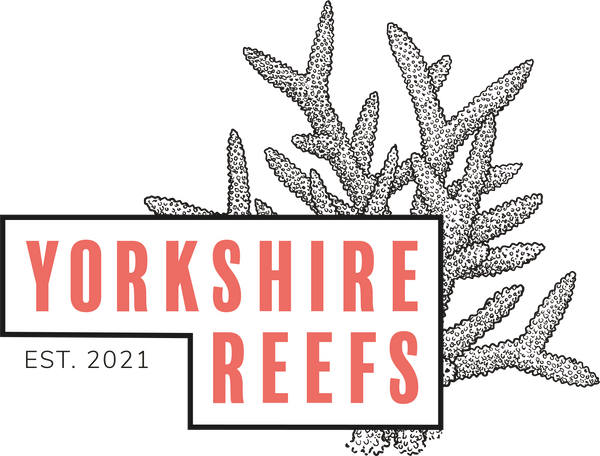An easy to follow, step-by-step guide.
When you start a new tank, it's easy to get overwhelmed. The advice we give to everyone is: be patient, test your water, and try and stick to one person’s advice. Every reef keeper does everything a little bit differently, and we’ve got specific methods that work for us and our customers. Sometimes, you can really do too much! So doing little bits here and there, and following this guide, should make you end up with a lovely tank.
Every aquarium will have moments when it doesn't look it’s best, but that’s normal as your tank matures. We tend to find that they really start to mature and start looking great at the 6-12 month mark. So, if you've got a young tank, take it nice and slow!
Step 1: Buy a tank
Bigger tanks are easier to care for, as changes in the water happen slower. Go for the biggest tank you can fit and afford. Have a play around on our tank builder, or pop into the shop so we can show you how it all works, and give you a quote for a setup that suits you.
Step 2: Set the tank up
Day One
Fill your tank with rock (we like Real Reef), and salt water. Turn on the return pump, powerheads, and roller filter if you have one. Check the salinity is 1.025-1.026. Turn on your heater and controller, and set the tank to 25.5 degrees celcius. Wait for the water to reach temperature (this might take a while!), and when it does, add live bacteria and live sand.
Step 3: Start checking Ammonia, Nitrite & Nitrate
Day Two
We want to make sure every aquarium has readings of 0 for ammonia & nitrite for 7 days before fish are added. A reading of nitrates are fine, and indicate that the bacteria which breaks down harmful ammonia and nitrite is working its magic. That’s good!
Keep testing ammonia and nitrite through the first few weeks of having fish. If you're getting readings of 0 every time, you can stop testing these.
Step 4: Add fish
Usually at days 7-14
It’s good to add fish slowly. A pair of clownfish are some of the best fish to get a tank started with. You can turn the lights on now - set them to acclimation mode if it’s an option. If not, start the lights on 30%, and turn the intensity up 5% a day. If you have a UV, turn this on now too.
Feed the fish once or twice a day - a mixture of frozen food and pellets work well. Feed them as much as they can eat in 30 seconds, it’s a lot less than you think! You can always add more food if it’s eaten quickly, but it’s harder to remove it.
You can keep adding fish every week or every other week from now on.
Step 5: Start testing nitrate and phosphate
From the day after the fish go in, weekly, for ever!
Now you have fish, you have a nutrient source in your tank. Test nitrate and phosphate at least once per week, but more often is better. We need to keep them balanced to lower the chances of algaes, and make sure the water is good for corals before they go in!
Your nitrate and phosphate will usually start off very low. It’ll increase with time the longer you have fish in, and the more fish you add. Watch it as it comes up. If it’s come up too much, you’re probably overfeeding. Don’t put any more fish in until you’ve brought those readings down.
It’s a good time to start adding copepods and phytoplankton to your tank. These help eat algaes, and provide food for fish. You can add things like snails and shrimps to your tank once you are getting some visible algae on the rocks or the glass - if your tank is too clean, the invertebrates can starve.
Turn on your skimmer once your nitrates have hit 5, or your phosphates have hit 0.06, or when you’ve had fish in for two weeks - whichever one is first, turn that skimmer on!
Step 6: Some more water tests
Usually at or around week 8 or later
If you’ve been adding fish for at least 6 weeks, and you’ve been getting stable nitrate and phosphate test results, you can add some corals. We like to start with a few different LPS corals, and can always talk you through our favourites for new tanks when you’re in the shop.
Before you add corals, we need to check KH and calcium. It’s normal for them to be a little bit low in new tanks, as the rock and sand will absorb some. Pop in for some supplements to raise them. We’ll let you know how much to add! Check out what parameters to aim for here.
Step 7: Add corals
Usually at or around week 8 or later
Now your water is looking good, corals can go in! Remember to start checking KH, calcium, nitrate, and phosphate weekly (at a minimum) from here onwards. You’ll need to do this forever - so it’s handy to keep a log somewhere of all your results.
When you get your first corals, buy some coral dip. This is a mixture you soak corals in before adding them to your aquarium, which will kill off any pests which may be on them. You’ll want to buy some coral food too, which we can talk you through using.
Step 8: Admire your beautiful aquarium
That’s it! You can keep adding to your tank. The best aquariums are built up slowly with patience. Do a little at a time, keep testing your water, and keep adding corals you like the look of. We’ll always be happy to talk you through individual coral requirements.
